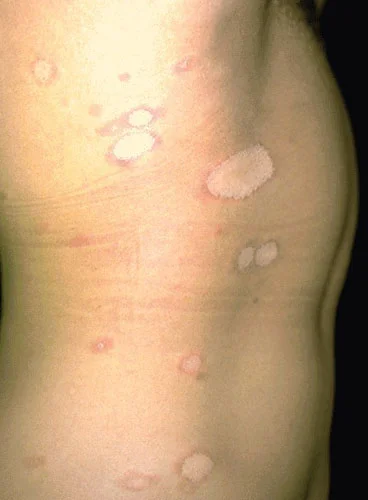
Overview
Pityriasis rosea is a disease condition identified by the formation of many small patches of scaly, rose-coloured, or tan-coloured patches on the skin.
Pityriasis rosea may be caused by a viral infection.
The most common symptoms are itching and an initial large, tan-coloured or rose-coloured circular patch. After which multiple patches appear on the torso.
The diagnosis is based on symptoms.
This disease usually resolves without treatment in most cases. And mild itching may be alleviated with artificial or natural sunlight.
The cause of pityriasis rosea is not certain, but infection with human herpesvirus type 6, 7, or 8 may be involved. However, the disorder is not thought to be contagious.
Prevalence
Pityriasis rosea most commonly occurs in people between the ages of 10 and 35 years. Pityriasis rosea affects women more often than men.
Women who develop pityriasis rosea during pregnancy (especially during the first 15 weeks of gestation) may have a premature or stillborn baby.
Our individuality or uniqueness as a person is the reason why some people experience pityriasis rosea more severely than others. Homeopathy values this uniqueness of yours.
Do you know …
Pregnant women with pityriasis rosea should be offered Homeopathy as a safer alternative. However, treatment with Homeopathy may or may not reduce the risk of premature birth or stillbirth.
Homeopathy is the safest and most reliable approach to ailments and has withstood the assaults of established medical practice for over 100 years.
Yehudi Menuhin, Famous Violinist
Hey! You are almost there to start your treatment.
Causes of pityriasis rosea
The cause of pityriasis rosea is not certain, but infection with human herpesvirus type 6, 7, or 8 may be involved. However, the disorder is not thought to be contagious.
The recurrent and long-lasting presence of patches can prevent people from doing what they usually enjoy and starts to affect the mind as well. They may become shy, depressed, and anxious. They may stop their activities, withdraw socially, and become preoccupied with their appearance. The mind-body complex is now fully affected and becomes a vicious circle which keeps an individual in suffering mode.
Symptoms of pityriasis rosea
Pityriasis rosea causes a rose-coloured or tan-coloured patch of skin about 1 to 4 inches (2 to 10 centimeters) in diameter that doctors call a herald or mother patch. The rose or tan colour is not as obvious in people with darker skin. This round or oval area usually develops on the torso. Sometimes the patch appears without any previous symptoms, but some people have a vague feeling of illness, loss of appetite, fever, headache, and sometimes joint pain a few days before the patch appears.
Development and progress
Initially, most people who have pityriasis rosea develop one large scaly patch called the herald patch (arrow), and, within 1 to 2 weeks, smaller tan- or rose-coloured patches can occur on the trunk, arms, and legs.
In 7 to 14 days, many similar but smaller patches appear on other parts of the body. These secondary patches are most common on the torso, especially along and radiating from the spine. In children, the patches commonly begin in the groin or underarms and spread outward. Children and pregnant women may have little or no scaling. Most people with pityriasis rosea have some itching, and in some people, the itching can be severe.
Diagnosis of pityriasis rosea
A doctor’s thorough evaluation which includes physical; mental; emotional; social health and environmental influence. Through this evaluation, doctors try to identify the causes, factors modifying it, and the impact of it on the daily life quality of a person.
A doctor usually makes the diagnosis of pityriasis rosea based on the appearance of the rash, particularly the herald patch.
Doctors ask how the person feels; eats; sleeps and goes through a routine day. Identifying these changes is critical because they can make the situation better or worse and, if present, must be treated for it to be treated effectively.
Homeopathic Treatment of pityriasis rosea
After a thorough evaluation, each case is worked upon and a set of similar medicines is derived, from which one single medicine which fits the patient’s presentation at that time, in relevant intensity and repetitions is given.
Some need only one medicine throughout the duration of treatment and some need a few in sequence one after another across the treatment.
Timely follow-ups are essential to keep moving forward toward the goal of treatment and to identify, manage and overcome any obstacles to the outcome.

Outcomes of Customised Homeopathic Treatment
Usually, the rash goes away within 5 weeks without treatment, although sometimes it lasts for 2 months or more.
With Individualised Homeopathic treatment focused on the person who is suffering, the outlook is as follows:
- Relieves itch
- Boosts metabolism
- Improves sleep
- Improves alertness
- Relieves fatigue
- Restores function
- Better moods
- Improves quality of life
Each person is unique and hence the time taken for treatment and the results achieved are also unique.
Try to consult a well-qualified professional homeopath who practices adhering to the tenets of Hahnemannian Homeopathy for the Best Outcomes.